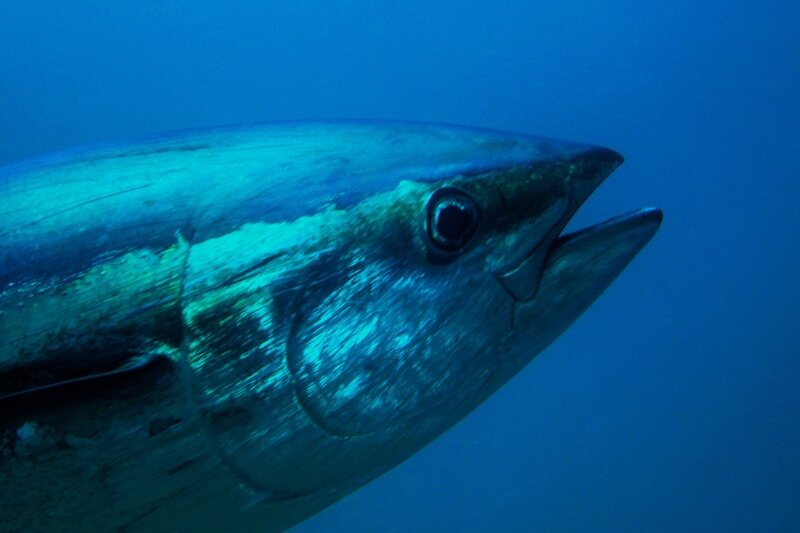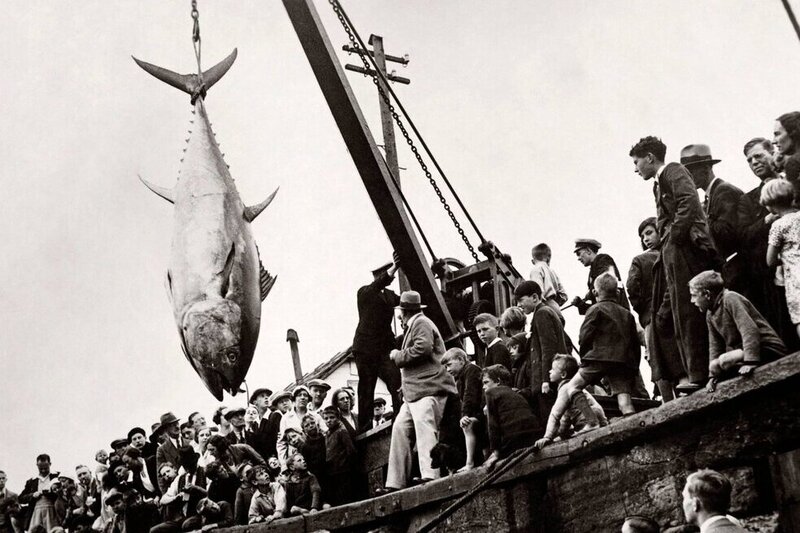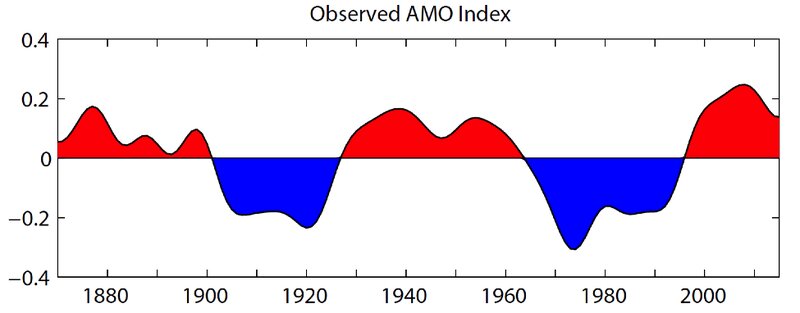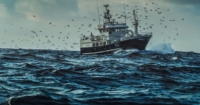As avid fishermen, it’s safe to say we’ve always been a little disappointed at the lack of true sport fishing in the UK. Sure bass and wrasse are great fun and pollock fight like hell, but it’s always felt like there’s something missing. It turns out that thing was right around the corner.
For many anglers around the world, there’s no greater thrill than the pursuit of one of the ocean’s most prized fish. The screaming reel, the rods wider than your thigh and the sight of said apex predator get the heart racing. For many of us, it’s why we love it.

Over the last decade, tuna have returned to the UK in their droves. For commercial fishing vessels and hobbyists, this has crystallised the idea that British waters are changing. Hopefully for the better. We’ve broken down their long-awaited return, where you can catch them and everything in between below.
A 2023 Guide to the UK fishing industry
Table of contents
Are there any tuna in UK waters?
After nearly 60 years of absence, tuna have returned to the UK and have been sighted since around 2014. In a remarkable turn of events we certainly never thought we would see in our lifetime, professional anglers are catching these apex predators off the UK’s south coast, Wales and Ireland. There are now 25 vessels that are legally allowed to catch tuna commercially so that scientists can collect data to understand why tuna have returned.
In the late 1920s fishing for tuna in UK waters was fairly commonplace. North-easterly ports around Scarborough, Whitby and Flamborough were famed for their tuna fishing and the British Tunny Club was founded in Scarborough in 1933 as a tuna-hunting playground for the wealthy. Tuna fishing was big business and so potent in fact that the world record – a 798lb tuna – was caught by Sir Edward Peel (the first President of the club) in 1932. The record was broken just one year later when an 851lb tuna was caught off the coast of Scarborough by Lorenzo Mitchell-Henry.

Understandably the Second World War saw a slowdown in big game fishing. When the 1950s rolled around, commercial fishing began decimating the populations of sardines, mackerel and herring. Tuna’s primary food source. Throughout the early to mid-20th century, the North Sea spawning stock of mackerel was large and lightly fished, where the development of modern sonars, power blocks and single-vessel purse seining led to a ten-fold increase in mackerel landings. Understandably tuna had to leave the North Sea and move south to find prey.
There is one other theory as to why tuna left and subsequently returned to UK waters and it is related to the Atlantic Multidecadal Oscillation (AMO). It is cited as a possible cause as the temperature shifts (or oscillations) tally up with the tuna population. The cooler waters seen after 1960 until recently could explain the fall and subsequent rise.
Where can you catch tuna in the UK?
Since tuna have started reappearing in UK waters they have been confined to the southwest coast. The warmer waters around Cornwall and Devon, where the higher sea temperatures and prevalence of oily baitfish create the best possible habitat for tuna in the UK.
Fishermen in Cornwall have teamed up with scientists to study the behaviour of bluefin tuna, to understand more about their behaviour and why they’ve returned. Whilst recreational tuna fishing is banned, commercial fishing licenses have been handed out to a select few (25 vessels at the time of writing) as part of the CHART scheme. This has led to over 1,000 tuna being tagged and measured – almost two per trip.
When shore fishing for bass around Prawle Point (one of Devon’s best sea fishing spots) in 2021 we heard some thunderous bangs coming from out to sea. As we looked up we saw huge tuna hunting and jumping out of the water no more than a couple of hundred yards offshore.
What is the best place to catch tuna in the UK and Ireland?
The southwest of England in Cornwall and Devon are two of the best places where you can legally catch tuna in the UK. You can also catch tuna in the Atlantic off the western Irish coastline (Sligo, Killybegs and Donegal are hotspots) and the southern Welsh coast, with some absolute giants caught in the Celtic Deeps.
The 25 vessels involved in the tuna fishing scheme in the UK are primarily based in the southwest of England. Until the population of tuna expands – in both numbers and territories – it doesn’t look like this will change anytime soon. In Ireland, the restrictions are put in place through the ICCAT (International Commission for the Conservation of Atlantic Tuna) and the same rules apply. Recreational fishing for tuna is still illegal and only 22 commercial vessels currently have licenses.
When can you catch tuna in the UK?
The fishing season for tuna is set out by CEFAS (Centre for Environment, Fisheries and Aquaculture Science) and runs between 15th August – 11th December each year in the UK. In Ireland the season starts and ends a little earlier, running from late July to November.
Whilst it’s a short period of time and could expand in the future, the initial process is designed to study the fish, understand its behavioural patterns and – in the future – look to provide further evidence for a live-release bluefin tuna fishery in 2023.
The 12 Best Sea Fishing Spots in Devon
Why have tuna returned to UK waters?
There are two primary reasons why scientists believe that tuna have returned to UK waters:
- The increasing population of sardines, mackerel and herring – tuna’s primary food source
- Rising sea temperatures thanks to the Atlantic Multidecadal Oscillation (AMO)
With more of a focus on fish stock management in recent years, conditions have become much more favourable for tuna. They tend to return to Cornish waters in late July and August each year when the sardines do. Since 2003 the total landings of sardines at Cornish ports have increased significantly, even though the fishing pressure (F) has been below the level associated with a maximum sustainable yield (MSY).
With an FMSY (Fishing Pressure Maximum Sustainable Yield) estimated to be around 50% and a yield that has increased by over 20 times in the last 20 years, sardine stock off the Cornish coast is in a good place.
The Atlantic Multidecadal Oscillation has been identified as a mode of natural variability occurring in the North Atlantic Ocean, with an estimated lifecycle of 60-80 years. The last 20 years have seen an increase in the sea surface temperatures in the North Atlantic (post 60 years of decline), creating more favourable conditions for Atlantic tuna. The AMO has been connected to a number of key events including hurricane activity and changes in fish populations.

It isn’t just UK waters that have spied the return of bluefin tuna. The Nordic fishery collapse in the 1960s remains one of the most spectacular fishery collapses of all time. Whilst it is primarily linked to overfishing, environmental influences cannot be ruled out. Most of the fluctuations regarding tuna populations in the Atlantic are concretely related to the Atlantic Multidecadal Oscillation.
However, the abundance of bluefin tuna in traps sometimes preceded shifts in the AMO phases. This is why it is so challenging to pinpoint exactly why tuna have returned.
The 11 Best Spots to Sea Fish in Cornwall
Is it illegal to catch tuna in the UK?
For the 25 vessels involved in the CEFAS-run CHART scheme, it is legal to catch tuna between 15th August – 11th December each year. For all commercial and recreational fishermen that exist outside of these parameters, it is illegal to catch tuna in the UK. This is to ensure the species’ survival in UK waters and to understand what has led them to return before they can be overfished.
What is the CHART scheme?
The CHART (Catch and Release Tagging Programme) scheme is a DEFRA-funded, CEFAS-run project that was set up in 2021 as a collaborative effort between the scientific community and the UK fishing community. 25 captains have been successful in applying to be part of the scheme and a collaborative approach between scientists and these vessels ensures safety measures are met, training in tagging and fish handling and data collection methods are provided.
The CHART scheme was only initially designed to run in 2021 and 2022, so there have been no decisions made as to the future of the project. But it looks likely it will continue into 2023 and beyond.
What is the biggest tuna caught in the UK?
Whilst the aforementioned 851lb tuna caught off the coast of Scarborough by Lorenzo Mitchell-Henry held the record for a long time, a nine-foot, 900lb tuna caught off the Welsh coast in 2022 is perceived to be the largest ever caught.
Fishing in an area known as the Celtic Deeps – an area recognised for its stunning habitats, species and big fish – two fishermen fought the tuna for an hour before it was tagged, measured and approximated weight-wise.
FAQs
Is there tuna in Cornwall?
Yes, there are tuna in Cornwall. Since 2014 we have seen tuna return to UK waters and the UK’s south coast – primarily Cornwall – has been a hotspot. This is where most commercial fishing vessels legally allowed to catch tuna exist.
Can you land bluefin tuna in the UK?
Yes, you can land bluefin tuna in the UK. Until the 1960s tuna fishing in the UK was big business and world records were consistently landed. As stocks of sardines and herring were dramatically overfished and sea temperatures cooled, tuna migrated south. But since 2014 the UK and Ireland have seen the return of the apex predator and a number of commercial vessels can legally catch them.
What type of tuna do you get in the UK?
The most common type of tuna in UK waters is the Atlantic bluefin tuna. These highly migratory species are found in colder waters associated with the Atlantic and North Seas. Yellowfin, albacore and skipjack tuna have all been caught in the UK, but they prefer warmer waters and are much less common than bluefin.
When did tuna return to UK waters?
Tuna returned to UK waters in 2014 after an absence of around 60 years. Tuna fishing was popular and populous from the 1920s up until the 1960s in UK waters. However, as overfishing of prey and the tune themselves occurred, the tuna moved south up until the mid-2010s.
Is it illegal to kill tuna in the UK?
Yes, it is illegal to kill tuna in the UK. From 2021 the UK government has set catch limits for vessels sanctioned to catch tuna as part of the CHART scheme. This is a catch-and-release scheme set up for scientific research that makes killing the fish illegal.
Even if tuna are caught as bycatch, the vessel in question is not allowed to land in UK ports.
Are tuna native to the UK?
Tuna are not native to the UK. They are warm-water fish that prefer tropical and subtropical waters and are not naturally found in the colder waters of the Atlantic and North Seas.
However, bluefin tuna are highly adept at living in colder water and the huge migratory distances they cover have led to them existing in many parts of the world, including waters around the UK.
What is the quota for tuna in the UK?
There is no quota for commercial fishing vessels looking to catch and sell tuna. This practice is illegal. However commercial vessels that are legally allowed to fish for tuna as part of the CHART scheme can legally catch tuna on a catch-and-release basis only.









